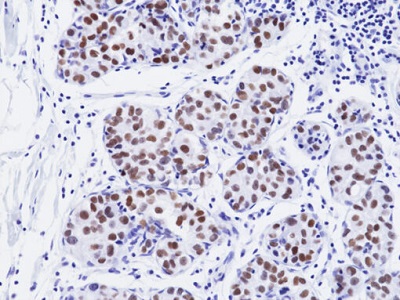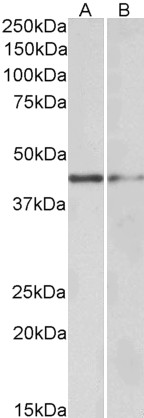
Immunohistochemical staining of formalin fixed and paraffin embedded human breast pleomorphic lobular carcinoma tissue section using anti-GATA3 Rabbit Monoclonal Antibody (RM482) at 1:100 dilution for 1 hr at room temperature.
anti-GATA3, Rabbit Monoclonal (RM482)
REV-31-1374-00
ApplicationsWestern Blot, ImmunoHistoChemistry
Product group Antibodies
ReactivityHuman, Mouse, Rat
TargetGATA3
Overview
- SupplierRevMAb Biosciences
- Product Nameanti-GATA3, Rabbit Monoclonal (RM482)
- Delivery Days Customer10
- ApplicationsWestern Blot, ImmunoHistoChemistry
- CertificationResearch Use Only
- ClonalityMonoclonal
- Clone IDRM482
- Gene ID2625
- Target nameGATA3
- Target descriptionGATA binding protein 3
- Target synonymsHDR, HDRS, trans-acting T-cell-specific transcription factor GATA-3, GATA-binding factor 3
- HostRabbit
- IsotypeIgG
- Protein IDP23771
- Protein NameTrans-acting T-cell-specific transcription factor GATA-3
- Scientific DescriptionGATA3 functions as a major regulator of T helper 2 (Th2) cell differentiation in immune cells. GATA3 expression is upregulated through IL-4 receptor signaling or the Notch-mediated pathway, which results in production of IL-4, IL-5, and IL-13 cytokines, responsible for preferential differentiation of Th2-cells. GATA3 has been shown to regulate early developmental processes of T cells, such as T cell commitment, positive selection, and post-commitment CD4+ T cell survival. GATA3 coordinates macrophage transcriptional activation and UCP2-dependent metabolic reprogramming in response to IL-33. Upon tissue injury, acts downstream of IL-33 signaling to drive differentiation of inflammation-resolving alternatively activated macrophages. GATA3 has been reported to be essential in the development of a variety of normal tissues. Defect in GATA3 results in hypoparathyroidism, sensorineural deafness, and renal dysplasia (HDR syndrome). - Recombinant Antibody. This antibody reacts to human GATA3 and may also react to mouse or rat GATA3, as predicted by immunogen homology. Isotype: Rabbit IgG. Immunogen: A peptide corresponding to human GATA3. Applications: IHC, WB. GATA3 functions as a major regulator of T helper 2 (Th2) cell differentiation in immune cells. GATA3 expression is upregulated through IL-4 receptor signaling or the Notch-mediated pathway, which results in production of IL-4, IL-5, and IL-13 cytokines, responsible for preferential differentiation of Th2-cells. GATA3 has been shown to regulate early developmental processes of T cells, such as T cell commitment, positive selection, and post-commitment CD4+ T cell survival. GATA3 coordinates macrophage transcriptional activation and UCP2-dependent metabolic reprogramming in response to IL-33. Upon tissue injury, acts downstream of IL-33 signaling to drive differentiation of inflammation-resolving alternatively activated macrophages. GATA3 has been reported to be essential in the development of a variety of normal tissues. Defect in GATA3 results in hypoparathyroidism, sensorineural deafness, and renal dysplasia (HDR syndrome).
- ReactivityHuman, Mouse, Rat
- Storage Instruction-20°C
- UNSPSC12352203




